August 8, 2014
Air Date: August 8, 2014
FULL SHOW
SEGMENTS
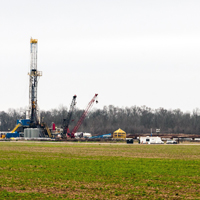
Groundwater Contamination on Fracked Land
View the page for this story
Natural gas is booming in the United States but many are concerned about the safety of extraction. A new AP investigation studied complaints of groundwater contamination from fracking, and reporter Kevin Begos tells host Steve Curwood all about it. (06:00)
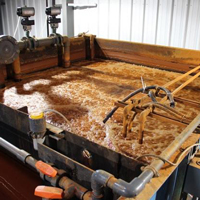
Fracking With Recycled Mine Water
/ Reid FrazierView the page for this story
Thousands of abandoned mines in Pennsylvania are full of polluted water. Now the natural gas boom is helping pay to clean up that water so it can be used for fracking to produce more gas. Reid Frazier reports. (05:30)
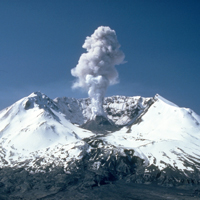
The Pros and Cons of Geoengineering
View the page for this story
In a bid to avoid some of the worst effects of climate change some scientists are advocating possible strategies to artificially alter the climate. But critics warn of unforeseen and dangerous consequences of any atmosphere altering intervention. David Keith from Harvard University and Clive Hamilton of Charles Sturt University in Australia debate the case for each side with host Steve Curwood. (17:10)
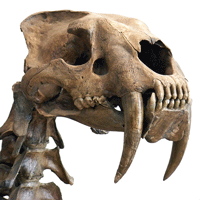
The Sixth Extinction
View the page for this story
Elizabeth Kolbert’s new book, The Sixth Extinction, explores the many ways humans are helping cause the largest extinction event since an asteroid wiped out the dinosaurs. Elizabeth Kolbert discusses what's happening with host Steve Curwood. (13:00)

Oregon Minnow Thriving and No Longer Endangered
/ Cassandra ProfitaView the page for this story
A tiny minnow called the Oregon Chub was put on the Endangered Species List more than 20 years ago. But the Chub has rebounded, and now officials want to make it the first fish ever taken off the Endangered Species List because of population recovery. Cassandra Profita reports. (05:33)
Show Credits and Funders
Show Transcript
Host: Steve Curwood
GUESTS: Kevin Begos, David Keith, Clive Hamilton, Elizabeth Kolbert
REPORTERS: Reid Frazier, Cassandra Profita
[THEME]
CURWOOD: From PRI, this is an encore edition of Living on Earth.
[THEME]
CURWOOD: I’m Steve Curwood-- The technique of fracking has brought us a bonanza of natural gas – and created an abundance of complaints about polluted ground water.
BEGOS: People are incredibly sensitive about groundwater contamination, I mean drinking water pollution really worries people. That’s part of the tremendous concern over fracking, you can’t necessarily see it, it’s happening deep underground and that’s why people are asking so many questions.
CURWOOD: Checking out the complaints – and an option to clean up already polluted water.
Also—a strong recovery for a tiny minnow—the Oregon chub has been brought back from the brink of extinction
SCHEERER: We have a little fish that most people didn't know about, few people care about and we've managed to recover them in a working landscape. I think it demonstrates what can be done.
CURWOOD: Those stories and more this week on Living on Earth. Stick Around
ANNOUNCER: Support from Living on Earth comes from United Technologies—innovating to make the world a better, more sustainable place to live.
[NEWSBREAK MUSIC: Boards Of Canada “Zoetrope” from “In A Beautiful Place Out In The Country” (Warp Records 2000)]
Groundwater Contamination on Fracked Land
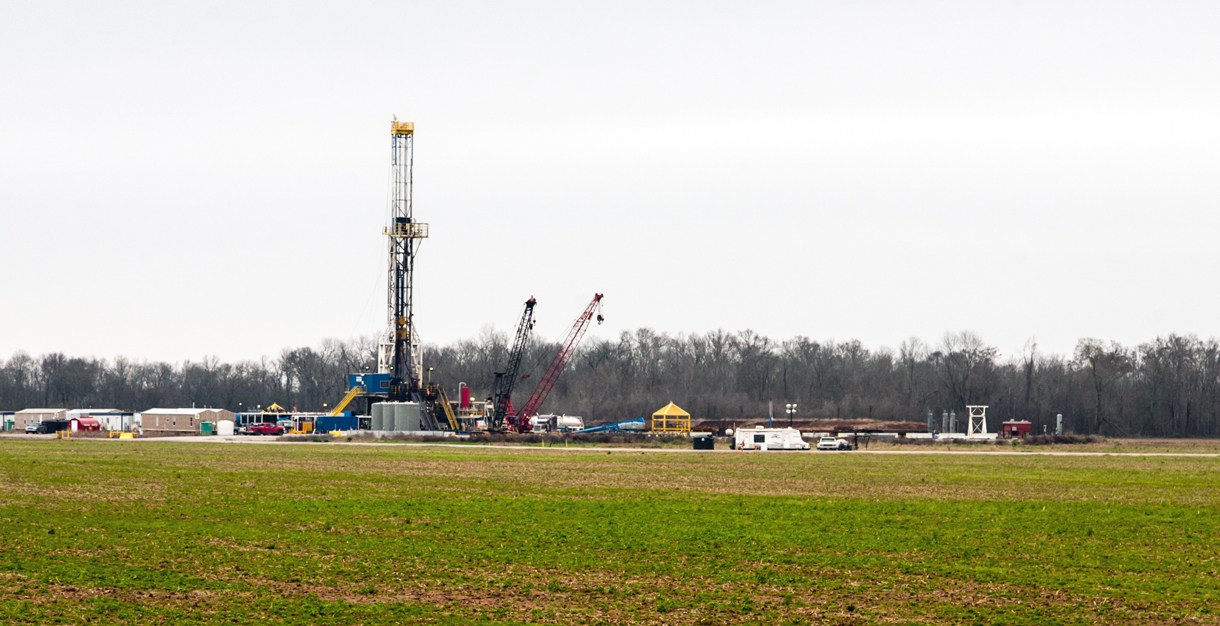
Natural gas fracking in Louisiana (Photo: Daniel Foster)
CURWOOD: From the Jennifer and Ted Stanley Studios in Boston and PRI, this is an encore edition of Living on Earth. I’m Steve Curwood. The increased development and use of natural gas is part of the White House's "all of the above" strategy for addressing global warming. But while natural gas burns much cleaner then coal or oil, hydraulic fracturing, or fracking, used to extract the gas from deep underground, has generated controversy, especially its impact on water. Fracking uses huge quantities of water and there are also concerns that it can foul the underground reservoirs of water that people tap for wells. Now an investigation by the Associated Press has documented hundreds of complaints of drinking water contamination near fracking operations in Pennsylvania, Texas, Ohio, and West Virginia. Kevin Begos is an AP reporter based in Pittsburgh.
BEGOS: We just tried asking four states to give us their most recent documents on the number of complaints. You know, we didn’t file a lawsuit or “right to know,” we just acted as if we were an average member of the public or a journalist starting from scratch.
CURWOOD: So what exactly did they give you, these four states?
BEGOS: We were surprised that it varied widely. Texas gave far more data, for example; the data of each complaint, the well location, summary of the type of complaint, the status of the complaint. Ohio, West Virginia and Pennsylvannia more just gave very rough summaries; “here’s the numbers of complaints we have, here’s the numbers we’ve confirmed,” but there’s still a lot of unknowns about the Pennsylvania data and the other states.
CURWOOD: How many complaints did you find records of?
BEGOS: Pennsylvannia had 398 in 2013 and 499 in 2012. Ohio had, starting in 2010, 37 and it went up to 54, then 59 in 2012. West Virginia had a total of about 122 complaints over the past four years. Texas had a smaller number, 62 water well complaints even though they had more than 2,000 complaints in general about oil or gas drilling impacting property.
CURWOOD: And of those complaints, how many were deemed valid by the state?
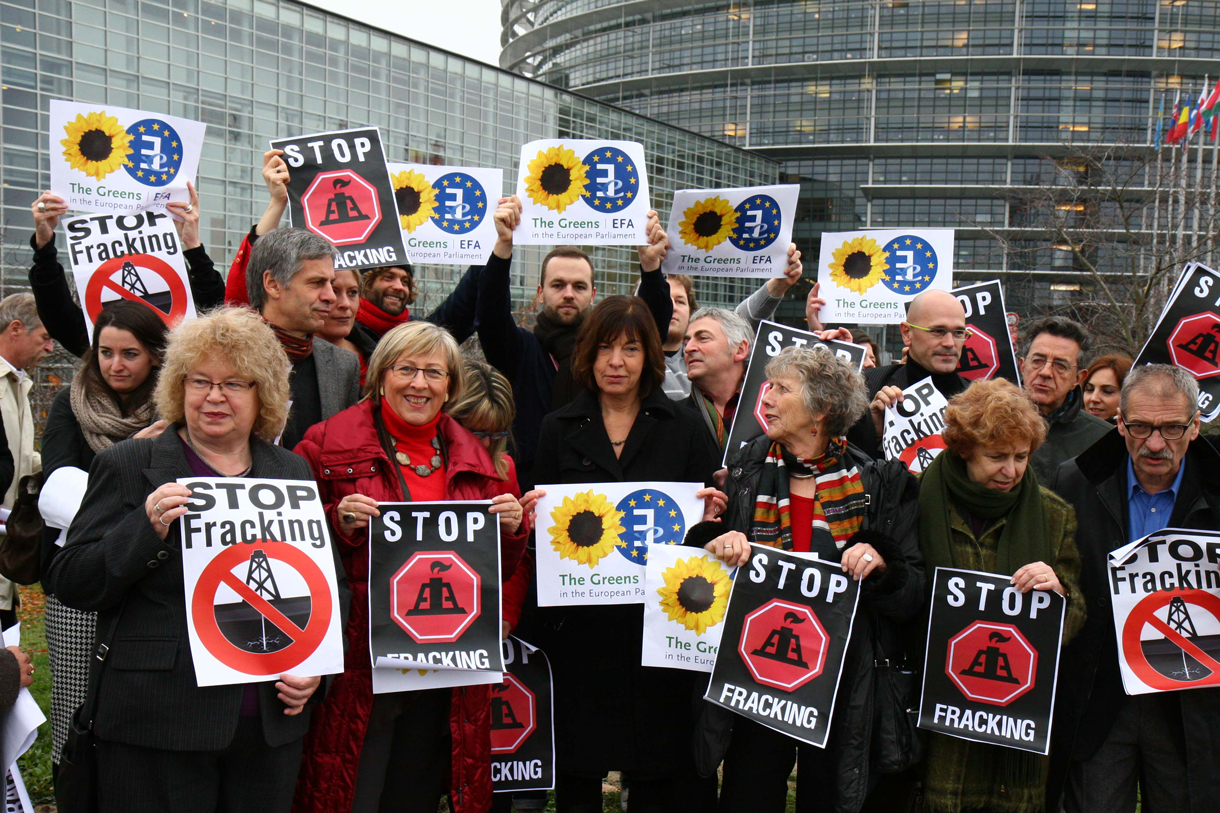
Fracking protest (Photo: greensefa)
BEGOS: Pennsylvannia’s comfirmed at least 106 since 2005. Texas says they’ve confirmed none of the alleged water well contaminations. West Virginia said four cases. The evidence was strong enough that the driller took corrective action, and Ohio has six confirmed cases. So one of the big questions is, are these investigations rigorous enough? How have they been conducted? Is this a realistic snapshot of how many people really have problems?
CURWOOD: What kind of contamination are we talking about here for water wells?
BEGOS: Some of the best researchers have been finding that methane seems to be by far the most common problem. There’s been tremendous debate over whether any of the fracking chemicals get into water wells, but in practical terms a lot of people are having much simpler problems, just things, for example, something spilling on the surface and going into a creek or impacting a well...or the methane, excessive natural gas in a well. So it’s really not just about the chemicals. It’s sometimes about more run of the mill pollution.
CURWOOD: Excessive natural gas, methane, in a well—what are the odds that it could go boom?
BEGOS: They have actually a baseline where they consider the danger of it exploding, and they’re finding small numbers of wells with that excessive high methane, some of them closer to natural gas drilling sites. Occasionally some of those natural water wells have very high methane, so that’s what makes it difficult to investigate, separating the background problems from the possibly drilling-related problems.
CURWOOD: This body of complaints that you found in Pennsylvannia. What’s your sense of how many wells might in fact be affected, as opposed to people speaking up?
BEGOS: See, that’s where it’s impossible to speculate, and that was really the bigger point we’re making. Anybody can guess at these things or give opinions that hardly any of them are contaminated or many of them are contaminated. But that’s just guesswork. There really needs to be more disclosure so that question can be answered. And that’s what makes people fearful, some of the experts have said, is that the uncertainty is perhaps even worse than whatever the truth is.
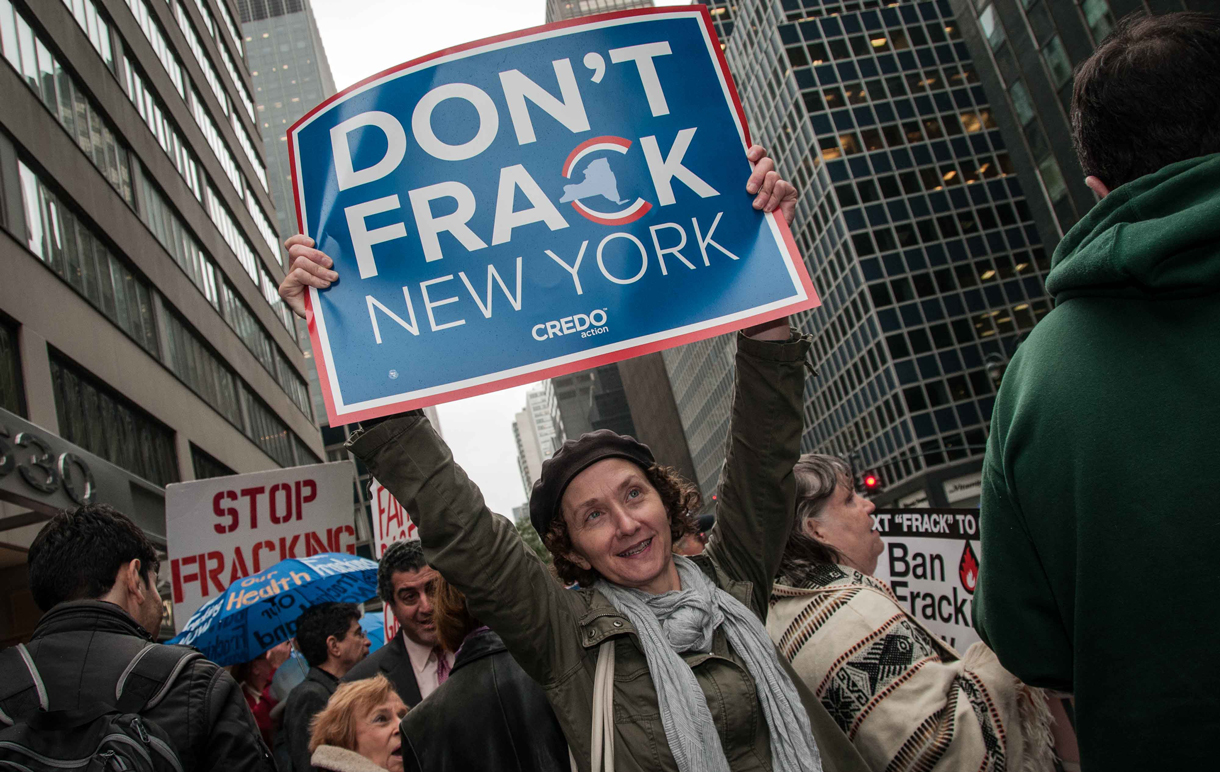
Anti-fracking demonstrators protest outside of New York Governor Andrew Cuomo’s office. (Photo: CREDO.fracking)
CURWOOD: So after doing all this reporting, what’s your impression of this groundwater question, what’s the takeaway?
BEGOS: You know, one of the experts we spoke to has pointed out that people are incredibly sensitive about groundwater contamination. I mean, there’s all sorts of issues in modern life, air pollution and various water pollutions are things people are worried about, but drinking water pollution really worries people, the potential for it. That’s part of the tremendous concern over fracking. You can’t necessarily see it, it’s happening deep underground, and that makes it harder for people to know what is or isn’t happening, and that’s why people are asking so many questions.
CURWOOD: Kevin Begos reports for the Associated Press from Pittsburgh. Thanks so much, Kevin, for taking the time.
BEGOS: Thank you so much for having me.
Related link:
Read AP reporter Kevin Begos’ piece “Some States Confirm Water Pollution from Drilling”
Fracking With Recycled Mine Water
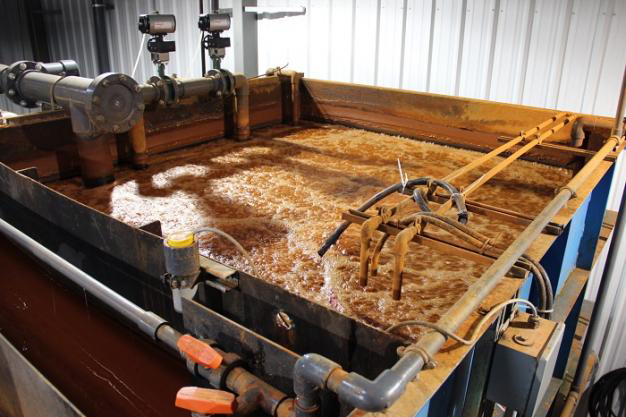
Iron colors the mine water red at the Blue Valley Abandoned Mine Drainage (AMD) Treatment Center. Money from gas company withdrawals is helping keep the facility working (Photo: Reid R. Frazier)
CURWOOD: One man’s trash is sometimes another man’s treasure, and that may be the case when it comes to water quality issues in Pennsylvania. The state is a center of the fracking boom – but there are also thousands of abandoned mines that leach metals and other pollutants into the state's streams. And now it appears that fracking could actually be one way to clean up this water, and some in the gas industry are pushing legislation to allow it. Reid Frazier of the public radio program the Allegheny Front caught up with some folks who are demonstrating the potential of recycling old mining water through fracking.
FRAZIER: Bill Sabatose stands in a small industrial building. He’s on a platform, next to what looks like a big hot tub, filled with really dirty water.
SABATOSE: We’re aerating it, we’re trying to oxidize the iron, so you can see how blood red it’s getting.
FRAZIER: The liquid is abandoned mine drainage, or AMD. This AMD came from a mine just up the hill. Sabatose has spent much of his life cleaning up this dirty water. He’s president of the Toby Creek Watershed Association, a local group that built and now runs this facility in northwestern Pennsylvania. The facility passes the AMD through a series of treatments. At the end of the line it flows into a tank the size of an above-ground pool. The water here is clear.
SABATOSE: In this particular tank we’re raising brown trout. A lot of people just love to come up here and just look at them, I guess it mesmerizes them. They just look like a big aquarium.
FRAZIER: The fish will be used to stock streams around the state. The clean water in the tanks eventually runs into the Brandycamp Creek, a tributary to the Allegheny River. Sabatose grew up here, near the town of Brockway. The region has a long mining history. The streams all used to be the color of rust.
SABATOSE: There wasn’t a fish within 100 miles of this place, so it was pretty bad.
FRAZIER: Since the group built this treatment plant in 2005 with a state grant, the Brandycamp started getting cleaner. But there was a problem. The watershed group had no idea how it would pay to keep the plant running.
SABATOSE: It was scary because we didn’t have a plan.

Bill Sabatose, president of the Toby Creek Watershed Association, at the Blue Valley AMD Treatment Center in Elk County, Pa. (Photo: Reid R. Frazier)
FRAZIER: Then around five years ago, a potential solution emerged: fracking. Drillers use millions of gallons of water, along with sand and chemicals, to frack natural gas out of underground rock formations. Frackers typically use freshwater, but a few companies approached Sabatose with an idea. Could they use his cleaned up minewater?
SABATOSE: Well, I thought “there’s all this water, and I need more money to treat all of it”... and I thought, “well, they were looking for water,” and I said ‘try it.’ And they tried it.
FRAZIER: And it worked. The gas companies paid Sabatose’s group for the water, although technically it’s a donation. And with the money the group could treat more abandoned mine drainage. This idea of using old mine water to frack is picking up steam in Pennsylvania. Regulators faced with a $15 billion abandoned mine problem want to see more of this. They see it as one way to get AMD out of streams by putting it in fracked wells. Some companies have already started doing it, but others are balking. Andrew Paterson of the Marcellus Shale coalition say the issue is liability.
PATERSON: The “you touch it you own it” concept.
FRAZIER: He says drillers are worried that they’d be held liable for the condition of the abandoned mine in perpetuity, even if they only used the water for a few months.
PATERSON: It’s not clear on a state or federal basis that if you were to use that water, that by using it you have not inherited the longterm treatment of that source of water.
FRAZIER: Watershed groups like Sabatose’s don’t have to worry about this state law protects them from lawsuits over the minewater they treat, because they’re considered good samaritans. A bill being pushed by the gas industry and the state’s Department of Environmental Protection would add gas companies to that list of good samaritans.
CARLUCCIO: Well, we see this as a “lose, lose, lose”.
FRAZIER: Tracy Carluccio is with Delaware Riverkeeper, an environmental group. She says gas companies are not good samaritans. Under the bill, companies wouldn’t have to clean up the minewater or buy it from groups like Sabatose’s. They could simply withdraw the water they need from a polluted mine.
CARLUCCIO: They’re not cleaning it up. They’re taking very polluted fluid and making them more polluted.
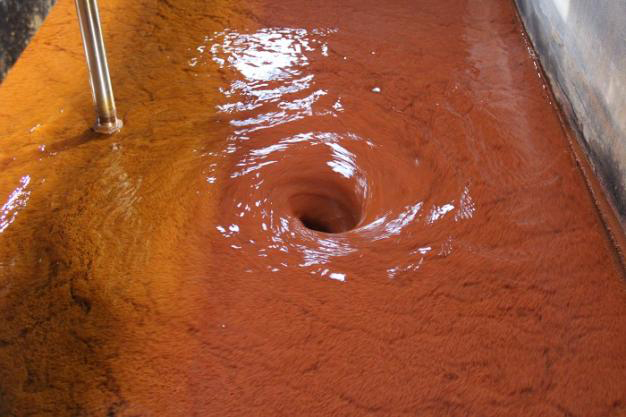
After iron oxides and sulfates are taken out of the mine water, it is discharged into Brandy Camp Creek (Photo: Reid R. Frazier)
FRAZIER: But some see this as a way to peck away at the state's historic abandoned mine water problem. Radisav Vidic, is an engineer at the University of Pittsburgh. He says allowing frackers to use mine water polluted from mines keeps that water from polluting the rivers.
VIDIC: If you think about it, AMD is already killing fish in the streams. If you take it out and prevent it from going into the streams, or if you clean it up before it goes into the streams, you can only make it better.
FRAZIER: Even if the bill passes, no one is promising that fracking could solve the state’s abandoned mine water problems. At current funding levels, cleanup of the thousands of historic coal mines in Pennsylvania is projected to take up to 50 years.
CURWOOD: Reid Frazier brought us that report from the Pennsylvania public radio program the Allegheny Front.
Related link:
Read more about using abandoned mine water to frack in Pennsylvania on the Allegheny Front’s page
[MUSIC: Soulphonic Soundsystem “Underwater Circuits” from Soulohonis Soundsystem Vol. 1 (Convincing Woodgrain Records 2007)]
CURWOOD: Coming up: with carbon dioxide levels higher than they've been in over a million years, we debate taking drastic action to cool the planet. Keep listening to Living on Earth.
[CUTAWAY MUSIC: Sonny Clark “Voodoo” from Leapin And Lopin (Blue Note Records 1962)]
The Pros and Cons of Geoengineering
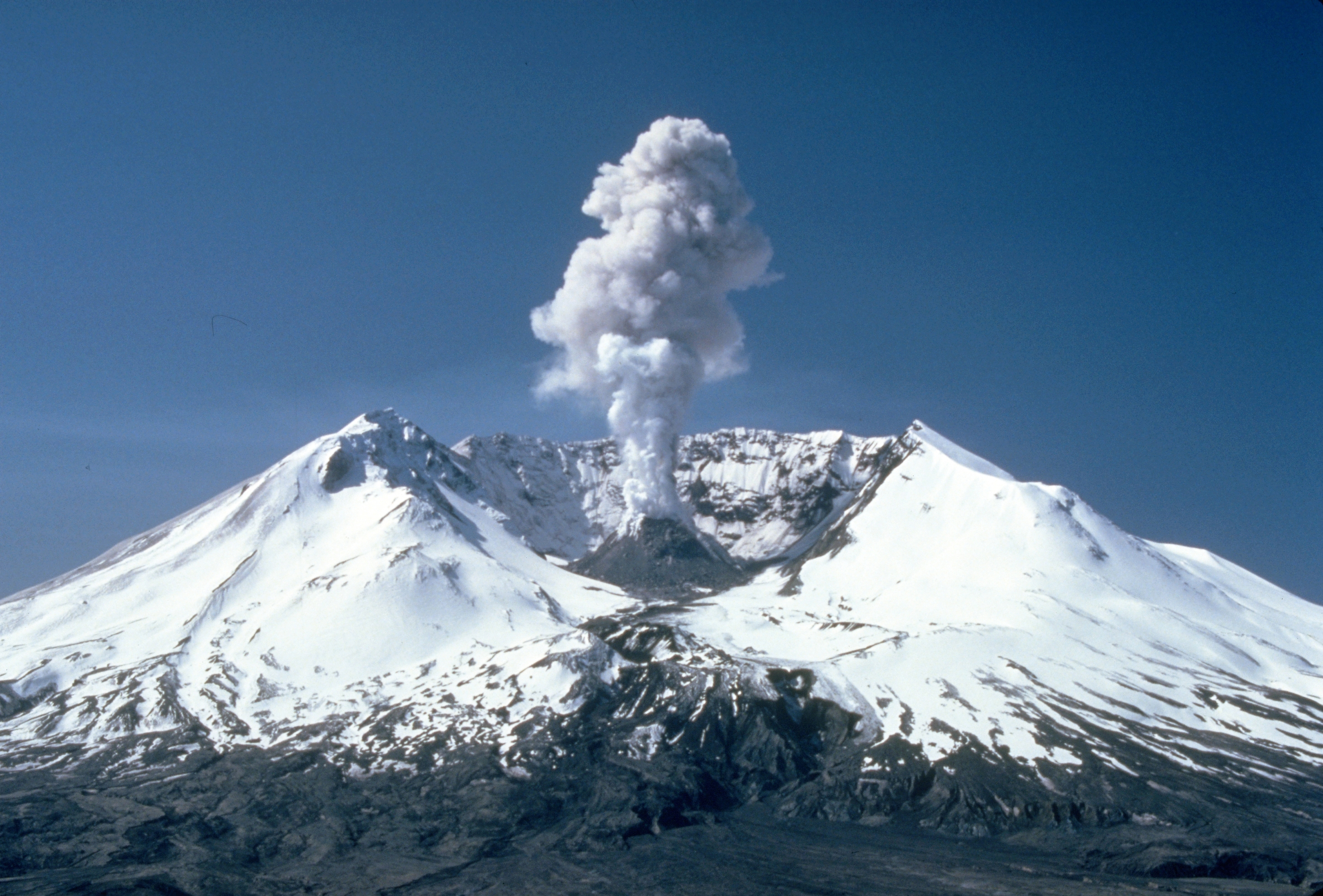
An example of natural geoengineering: Volcanic eruptions emit sulfur dioxide, which can cause cooler temperatures. (Photo: U.S. Geological Survey)
CURWOOD: It's Living on Earth, I'm Steve Curwood. Since we started farming in the Fertile Crescent over 10,000 years ago, human activities have been altering the climate. But since we started burning vast quantities of fossil fuels about two hundred years ago, emissions of polluting gases into Earth's atmosphere means levels of CO2 have soared to levels not experienced in more than a million years, and heated the planet to levels not seen since civilization emerged. So scientists have started to contemplate the once unthinkable and impossible -- to find a way to take carbon out of the atmosphere, and cool the planet. And there are ways we might possibly do that
WOMAN 1: We could plant billions of trees.
MAN: We could use chemical sponges to suck CO2 out of the atmosphere, then bury them.
WOMAN 2: Or we could block some of the sun's heat from the earth with a cloud of droplets of sulfur dioxide.
CURWOOD: Well -- some scientists argue that last solution -- a solar shield - is the most plausible. They point to the effects of eruptions from volcanoes like Mount Pinatubo for evidence that it works. We've invited into our studio two highly regarded experts with decidedly different views to debate this issue. In what we might call the blue corner is David Keith, who divides his time between Harvard University, and a Carbon Engineering company in Calgary, and is author of a recently published book “A Case for Climate Engineering” – David Keith, welcome to Living on Earth!
KEITH: Thanks a lot. Great to be here.
CURWOOD: And over in the red corner, we have Clive Hamilton. He’s a Professor of Ethics at the Centre for Applied Philosophy and Public Ethics at the Charles Sturt University in Canberra, Australia. And his recent book is called Earthmasters: The Dawn of Climate Engineering.
CURWOOD: Professor, welcome to you.
HAMILTON: It’s good to be here.
CURWOOD: So gentlemen, let’s agree at the very beginning that your views aren’t entirely opposite. In fact, both of you say any attempt at geoengineering would be very serious, even potentially a hazardous step to take, but why do we need to do this? David Keith, sum up for us basically this case for geoengineering.
KEITH: The simple case for taking seriously the idea that we might find technological ways to increase the reflectivity of the Earth, say by putting a kind of pollutant sulfuric acid in the upper atmosphere to reflect away a little sunlight and cool the planet, The significant case for doing that is it appears on technical grounds that it could, in a temporary and imperfect way, substantially reduce the risks for carbon in the atmosphere. It’s one of the few ways we know to materially reduce the risks over, say, the next half century, risks that will fall most on people who are relatively poor and vulnerable living in the hottest parts of the world and also risks to the natural world that is seeing unprecedented levels of climate change.
CURWOOD: Sounds all very reasonable, Clive Hamilton. What’s the problem?
HAMILTON: Well, when we think about it a bit more, the proposal is to coat the Earth with a layer of tiny sulfate particles, to reduce the amount of sunlight that reaches planet Earth. First of all, we’re not actually tackling the problem of climate change, we’re just suppressing one of its symptoms, that is, the warming of the globe, but the other impacts of climate change will continue, for example, and in particular, the continued acidification of the oceans. And one of the biggest problems with this solar shield would be we can’t test it, we can’t do it in a small way to see if it would work in a big way. In order to see if it would actually work in the way anticipated as in David’s book, we would actually have to implement it...install the solar shield, surround the Earth with a layer of sulfate aerosols, and then sit back and monitor the climate and hope that it worked. But we know the climate system’s incredibly complex. There would be surprises, some of them probably nasty, so that we could actually make the situation worse.
CURWOOD: But what about the fundamental concept here that he’s put forward that, hey, we should be looking at engineering solutions that would ameliorate the effects of climate disruption.
HAMILTON: Well, I think geoengineering is a way of trying to get around a social and political problem with some kind of techno fix. And we’re talking about taking control of the climate system of planet Earth and regulating it to suit our needs. If political leaders believe that they have a technogical solution that will obviate the need to take on big fossil fuel corporations, then they will use it as a substitute for doing what they should be doing, that is, cutting greenhouse gas emissions. If we think about what it means to try and essentially install a thermostat in the climate system it raises the fundamental question of who is going to have their hand on the global thermostat.
CURWOOD: David?
KEITH: I think one thing that Clive does, and did here, is to attempt to say that people advocating research in this technology like me are doing it as a way to avoid the social change we need. And to put it simply, it’s nonsense. So there are a lot of reasons why this might be wrong, why my advocacy of this might be dangerous, and I lie awake at night worried about them and did long before Clive first thought of it.
So the idea that there’s a kind of moral hazard, that this might allow fossil fuel interests to avoid regulation, I’m the one, I believe, who used that term “moral hazard” in this debate 15 years ago. So I’m hardly unaware of it, but the idea that I and other people working on this somehow think that this can only be done by technology and that we can avoid a social solution is at least in my case, utter nonsense. I’ve just come close to losing my job in Calgary because of clear advocacy that we need social change to eliminate carbon emissions. I think it’s kind of a cheap shot.
I think Clive needs to take seriously the fact that most of the people working on this actually are very serious about the kind of social changes needed, and we may still be wrong to advocate it, but Clive needs to take us on on the reasons we’re wrong, not on a kind of ad hominem attack that we really just like techno fixes and want to as he said in his book “mollify the owners of the fossil fuel infrastructure.” That’s nonsense.
HAMILTON: But I haven’t claimed that at all.
KEITH: Uh, well actually, I’m reading a quote.
HAMILTON: No, no. I haven’t said that at all. Some of the scientists advocating geoengineering, in fact, most of them, I think, are motivated by the best of concerns, that is they’re deeply concerned about the damage of climate change on people and the natural environment and they’re looking for a solution.
I’m not worried so much about the scientists who are doing work on geoengineering, I’m worried about the political and corporate actors who are drawn to geoengineering as a response to climate change. And so already we see companies like Exxon and Conoco-Phillips and Shell dipping their toes in their water. We see conservative think tanks in Washington saying “Ah-ha! Here’s the answer to climate change. We don’t need to reduce carbon emissions. We can instead deploy these geoengineering solutions.” So it’s not the motive or the work of these scientists engaged in geoengineering that’s the problem. It’s the people who will take it on as a political solution to climate change.
CURWOOD: David?
KEITH: On that score I think the key issue is thinking creatively about how to manage the problem. So specific things like ensuring funding is public, like banning patenting in this area. Like finding specific ways to prevent the kind of technological lock-in, institutional lock-in that will advocate for this solution even if it turns out to be a bad one.
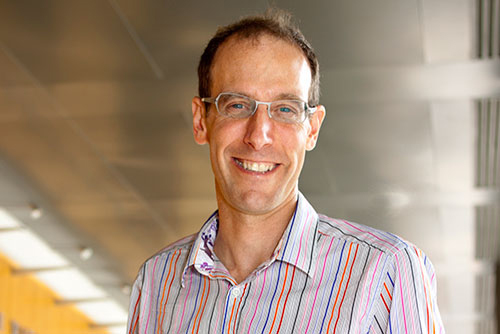
David Keith is a professor at Harvard University and author of A Case for Climate Engineering. (Harvard University)
CURWOOD: David Keith, just for the record, um, what funding do you get from the fossil fuel industry?
KEITH: From the fossil fuel industry, zero research funding. For a company that I run called Carbonation Ring, that’s attempting to use methods of getting CO2 out of the atmosphere to develop low carbon fuels, we have some funding from people who are tightly allied to the fossil fuel industry, one of them a guy called Murray Edwards.
CURWOOD: Clive Hamilton, for the record, funding from fossil fuel folks or...
HAMILTON: No. No. No.
CURWOOD: ...well financed opponents of fossil fuels?
HAMILTON: No. I get paid from my university and royalties from the book if it sells.
CURWOOD: David Keith says that your attacks on his position are, well, ad hominem. They’re personal. They ignore the nuance that he has in his book that he’s calling for research on this, that we should understand what the options might possibly be, but to ignore it at this point would be perhaps to do something at our peril.
HAMILTON: Well, firstly, David has gone beyond just calling for research into sulfate aerosol spraying. His latest book says in fact we should pursue a research program, but if the research supports geoengineering’s early promise, then he would choose gradual deployment of the sulfate aerosol spraying. So the worst I would accuse David of is naivete in thinking that scientists can go ahead with their research program and somehow, now or down the track, quarantine their research from the kind of political use that would be made of the technology should it prove to live up to what he calls its promise.
Because it won’t be David or his fellow scientific researchers who implement, who deploy this solar shield around the Earth, it will be one or more governments. I mean, for example, China is now starting to include geoengineering in its Earth Science research priorities. Russia, in particular, pushed strongly for a strong pro-geoengineering statement in the last IPCC report. So there are lots of political players coming into this domain, and it means these scientists, and most of them including David have perfectly good motives in pursuing this, but it’s naive to think that they’re engaged in pure research which can then be assessed and not be taken up by political actors with sometimes quite inappropriate and even dangerous motivations.
KEITH: It would be completely naive, it would be idiotic to say that. Which is why I and many people have spent a lot of time thinking explicitly about all the ways this research could be used in horrible ways. So going back to the first thing I wrote in the early ’90s, we talked about ways it could be used for war, we talked about ways it could be used to defend interests, I’m actutely and painfully aware of the fact that these are hard political decisions and that the interests of the environmental community who developed them will not be the ones that make the decision.
So I think let’s go beyond this kind of “do we know that or not” and talk constructively about how we deal with that head on, and to be absolutely clear, this in no way is a substitute for cutting emissions. In the long run, emissions stay in the atmosphere for millenia, and if you don’t bring emissions to zero, you will have a climate radically different from today’s. But the fact that geoengineering can reduce the risk in an imperfect way is not argument in itself for ignoring the possibility of reducing that risk.
CURWOOD: So, in other words, you’re not saying to do this instead of reducing emissions, but to do this with the reduction of emissions.
KEITH: Of course, and I’m not just saying it; I’ve invested far more of my personal time in lobbying to cut emissions, and taking personal risks to try and see emission cuts than I have for lobbying for stuff related to geoengineering. But the fact that there’s a trade-off here is not an argument for not using a potentially risk-reducing technology. So if you introduce anti-AIDS drugs, some people will go ahead and have more risky sex, but it would be perverse in the extreme to argue that is a reason not to introduce such drugs.
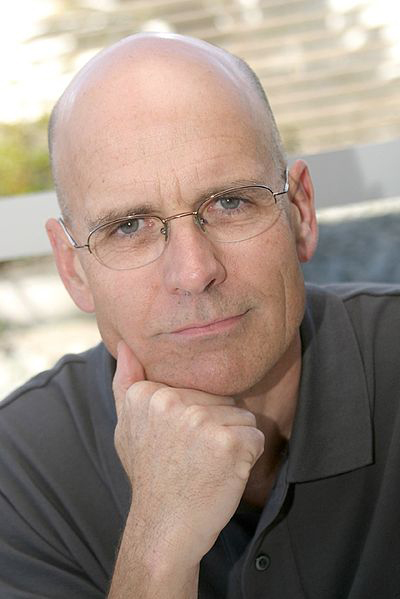
Clive Hamilton is a professor at Charles Sturt University and author of Earthmasters The Dawn of the Age of Climate Engineering.. (Photo: Courtesy of Clive Hamilton)
CURWOOD: David Keith, right now, what would you recommend the United States do in this area of looking at geoengineering? Suppose we weren’t simply talking on the radio program Living on Earth, but we were at the White House. We have the President’s ear and you have just a moment to explain why and how we should do this. What would you say?
KEITH: Have a modest and decentralized research program, and so I would advocate a research program that was very careful to be public, to push out private interests, and be careful the research program spent most of its money actually funding work to find out how it wouldn’t work, and only a small amount trying to develop ways it would work, and I wouldn’t have that in a single institution because government institutions just like private industry suffer from institutional lock-in, and so I would attempt to have a dispersed program, with pros and antis separated.
CURWOOD: Clive Hamilton, how does that sound to you?
HAMILTON: Well, one of the fascinating things about this push for research into geoengineering, particularly, sulfate aerosol spraying, is that we’ve seen a number of conservative think tanks in Washington like the American Enterprise Institute and the Cato Institute, which for years have been denying that climate change exists, have now come out in favor of sulfate aerosol spraying. So, you know, this sounds weird, how can they advocate a solution to a problem they’ve been saying doesn’t exist? And you can see why. Actually their arguments are not about the science, but about ideology. So, whereas climate change represents a drastic failure of the free enterprise system, geoengineering could turn that into a triumph of human ingenuity. Instead of climate change calling on us to be more humble about our relationship to the natural world, geoengineering, the techno fix to beat all techno fixes, promises greater mastery over nature. So you can why those conservative organizations are attracted to this, and that’s why whatever the beneficial motives of those doing the research are politically - there’s a real quagmire here - that could derail the whole process and lead us into a worse world than we’re going to have anyway.
CURWOOD: We’re just about out of time here, gentlemen. But David, Clive is saying that his kind of thinking, that the notion of geoengineering is leading us into a trap at the end of the day.
KEITH: I think what he’s saying is that it could, and I agree. I think there’s a real risk, that just the thing Clive was talking about will happen. I think the answer is it’s a new thing, and we don’t know what will happen, and it’s splitting the political dynamic in interesting ways. So on the left you see people from the green world who really want to see research in this in a serious way and other ones who dead oppose it. And on the right you see the thing Clive has talked about. What I hope is we can turn the tables a bit on Cato and say well you can’t at the same time say this and deny the science. So let’s cut some kind of deal where you accept a rational reality of science and we move towards to restricting carbon emissions.
CURWOOD: Clive Hamilton, what do you think are the deeper ethical issues of geoengineering?
HAMILTON: One reason why I find geoengineering so fascinating is because it does pose some very big questions about the state that humanity finds itself in. Here we are, transforming the climate system on planet Earth through putting carbon pollution into the atmosphere which is going to completely change the Earth’s system for thousands of years. So what kind of creature have we become when we say the answer to this is to take control of the Earth’s system and regulate it to suit our needs. I think this is a very profound event in human history. Sometimes people use this phrase “playing God”, this idea that we imagine that we are so omniscient and so omnipotent that we can essentially fulfill the role that God traditionally did, and that is to create circumstances in which life on this planet evolved. So I think there’s some very deep theological, philosophical and ethical questions that geoengineering raises.
CURWOOD: David, did you want to respond to what Clive just said?
KEITH: Yeah, not to disagree, but to have a different take maybe. It never makes sense to use kind of engineering methods to make nature more natural. I think there is not an easy answer to that, but this anecdote may be helpful. As a boy I worked on Peregrine falcon reintroduction with my parents, and that was an engineered system, we built boxes and imported falcons that were bred in captivity from across the country to try to reintroduce them into Eastern North America, and that reintroduction program was only conceivable because we had banned DDT, the thing that had killed them. And in fact I would say it worked. We have free living Peregrines now through a combination of the DDT and the reintroduction program.
And I think you can ask whether it’s possible to think about that analogy at global scale. It only makes sense to manage climate if we, in the end, bring emissions to zero. But the fact that that’s true doesn’t mean it might not also be worth doing some explicit engineering to try and reduce the rates of climate change.
CURWOOD: Gentlemen, I want to thank you both for taking the time with me today. David Keith’s book is called A Case for Climate Engineering, and Clive Hamilton’s book is called Earthmasters: The Dawn of the Age of Climate Engineering. Thank you both.
KEITH: Thank you.
HAMILTON: Thank you very much.
Related links:
- A Case for Climate Engineering
- Earthmasters: The Dawn of the Age of Climate Engineering
[MUSIC: Funkadelic “Good Thoughts, Bad Thoughts” from Standing On The Verge Of Getting It On (Westbound Records 1974)]
CURWOOD: Coming: How disappearing species and global warming are linked --
That's ahead here on Living on Earth – stay tuned.
ANNOUNCER: Funding for Living on Earth comes from United Technologies, a provider to the aerospace and building systems industries worldwide. UTC Building and Industrial Systems provides building technologies and supplies, container refrigeration systems that transport and preserve food and medicines, with brand names such as Otis, Carrier, Chubb, Edwards and Kidde. This is PRI, Public Radio International.
[CUTAWAY MUSIC: Junior Cook: “Illusion Of Grandeur” from Something’s Cookin (Muse Records 1993)]
The Sixth Extinction
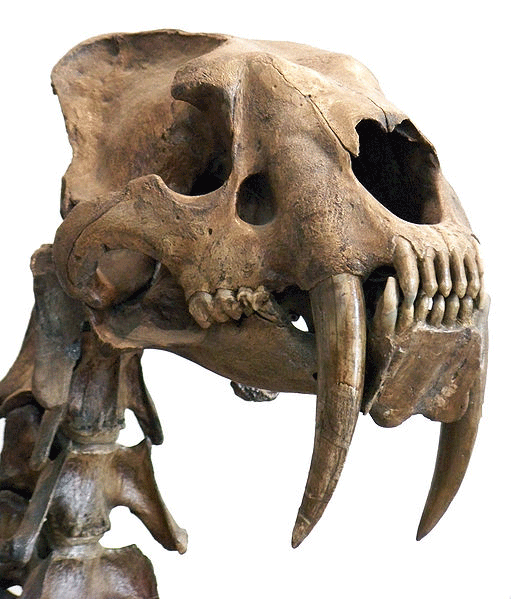
This Saber-toothed tiger went extinct at the end of the Pleistocen Epoch, some 11,000 years ago. (Photo: Wikimedia Commons)
CURWOOD: It's Living on Earth, I'm Steve Curwood. To research her book, “Field Notes from a Catastrophe”, New Yorker writer Elizabeth Kolbert traveled the world to find places where climate change is already having an impact. For her latest book, Elizabeth Kolbert again packed her bags, but with a different aim; to see how climate change, and other impacts of the human race are causing the largest mass extinction since an asteroid wiped out the dinosaurs some sixty-five million years ago. Elizabeth Kolbert says this book, The Sixth Extinction, An Unnatural History, is in many ways a sequel to her previous one.
KOLBERT: I actually went looking for a follow up, another book on climate change to do, because I thought climate change, wow, that’s such a huge story; surely I have not exhausted that story yet. And while I was looking around for that, I really came to the realization that climate change is just part of an even bigger story, which are the many ways in which people are changing the planet on a very grand geological scale that will be essentially permanent. We’re changing the world in ways that geologists in the very distant future will still be able to see that something very, very unusual happened at the moment that for us is the present.
CURWOOD: Of course, there’s a lot to talk about, but first let’s talk about a couple of the five extinctions, before this sixth one that humans are driving. It strikes me that these were all somewhat random.
KOLBERT: Yes, I think that’s a very important point to make. The worst of what are called the “big five” of the last half billion years occurred about 250 million years ago. It’s known as the end Permian extinction, and it wiped out something like 90 percent of the species on the planet. And people say, scientists who have studied it say, it came perilously close to wiping out multi-cellular life altogether and sort of pushing the planet back to the state of having only uni-cellular life.
The best hypothesis right now is that it was caused by this massive burst of volcanic activity that took place in what is now Siberia, and formed a formation known as the “Siberian Trap”, which is this huge lava flow that stretches over thousands and thousands of square miles, and that that released a lot of CO2 somehow, it’s not even clear exactly how because it doesn’t follow even from this massive burst of volcanism that that much CO2 would have been emitted, but a lot of CO2 was emitted into the atmosphere, it warmed the planet very radically and it acidified the oceans, it changed the chemistry of the oceans very radically. And one of the very sobering parallels between what we’re doing and what happened at the end of the Permian period is we are also emitting massive amounts of carbon dioxide into the atmosphere and doing it very very quickly.
CURWOOD: Now, talk to be about how you see climate change and the burning of fossil fuels as the driver of extinction for marine creatures.
KOLBERT: In the case of marine creatures, they’re being hit with at least a double whammy. I mean there are many other forces as you know affecting marine life these days. But two big effects of carbon emissions: one is climate change, which is warming oceans very very rapidly just as its warming our land masses but also what happens when you emit CO2 into the atmosphere is a lot of it gets dissolved in the oceans. It gets absorbed by the surface layer of the oceans and it dissolves in the water and when CO2 dissolves in water it forms an acid, carbonic acid. It’s a very weak acid, and you drink it when you drink Coke or club soda. But you pour enough of that into the water and it’s changing the water chemistry.
CURWOOD: Now, you went out with some researchers who are looking at the effects of carbon dissolving in the oceans.
KOLBERT: Yes, I went out with a guy named Jason Hall Spencer who had a really interesting revelation one day when he was taken to go swimming in this spot in the Bay of Naples where there are volcanic vents. So there are these vents at the bottom of the sea that are spewing what turns out to be almost pure carbon dioxide into the water and acidifying the water there - very much in the same way we are acidifying the water - and it occurred to him if he could map what lived in that area, you could sort of look forward in time. And as the chemistry changes, what’s going to happen to marine life.
And he did this very elaborate census, which required him to spend hours and hours sitting under the water counting every mollusk that was roaming by. You could see that when you were far away from the vent, several hundred yards away, you could see there were sea urchins and there were sea cucumbers and there were all sorts of seaweed and then as you got closer and closer to the vents, various things started to drop out, and then when you got right up close to the vents, it was sort of like a lunar landscape. And there were these sort of unfortunate creatures, these mollusks or limpets that had wandered in and their shells were starting to dissolve. You could see that they had these pitted shells, in some cases holes in them because the effect of the water was to actually eat away at their shells.
CURWOOD: And this is like a tenth of a decimal point change in the acidity of the ocean there.
KOLBERT: Well, so far we have affected a tenth of a decimal point change. We’ve already done that and because the Ph scale is a logarithmic scale, that represents a 30 percent increase in acidity already, so since the start of the Industrial Revolution. And if we continue on our present course, by the end of the century we will have affected basically a 0.4 change in the Ph scale, and that represents 150 percent increase in acidity.
CURWOOD: Now we know that the polar regions of the Earth are warming much more quickly that the Equatorial areas, Polar bears are a poster animal for climate disruption, but in your book you note that species in topical areas, including rainforests, are actually at more risk of extinction. Can you explain that?
KOLBERT: Yes, I mean it’s really interesting. As you pointed out the Arctic is warming very very fast, and that’s absolutely true, and if you’re a creature that’s dependent on Arctic sea ice which isn’t going to be there quite possibly in the summer within just a few decades from now, you are quite possibly a creature that’s in a lot of trouble. But the fact is that most organisms live in the tropics, the vast majority of species on Earth live in the tropics, and one of the defining characteristics of species that live in the tropics seems to be that you occupy this very narrow range of climate conditions.
So, for example, I went to the Andes with a scientist named Miles Silman, and what he had done was laid out these plots of trees where they’d literally counted every tree and identified what species they were from, and these plants ran down a ridge so that each of these plots has a different average annual temperature. And as we were walking down this mountain to look at these plots, he said to me, find a leaf on the forest floor that has an interesting shape and watch it, and you’re only going to find this leaf for a couple hundred yards because the range of this species is so narrow that you can follow it just as we walk along and let’s say an hour or half an hour. You have now gone through the entire range of this species. So these species seem to have very specific climatic conditions that they need, and as we change them, once again, what’s going to happen? Presumably some of them are going to move and he’s found that that’s the case. Some species are effectively moving up slope, but some are just sitting there. They don’t seem to have the ability to move. So we’re going to find out what’s going to happen to them.
CURWOOD: So let’s talk about some smaller extinctions for a moment. You note in your book that as early humans settled the Earth there were pulses of extinction of the large megafauna, you know, the mastodons, and the mammoths and the sabertooth tiger and all that followed them. You say that we didn’t really notice it at the time. Could you tell me the story and what it means?
KOLBERT: Sure, until relatively recently on Earth on all the different continents there had been these huge, huge animals which now on several continents, you didn’t find them anymore. You didn’t find them anymore in North America, you didn’t find them in South America, and in Australia you had these enormous marsupials, which are known colloquially as rhinoceros wombats. You didn’t find those anymore. They also in Australia had these giant tortoises that you didn’t find anymore, and what seems to be pretty clear from the evidence now is that the pattern and the timing does track when humans arrived in a continent.
CURWOOD: And so, what did we do as humans?
KOLBERT: The prevailing theory right now is that we simply hunted them. What large animals tend to share - certainly large mammals - is that they have a very low reproductive rate. So you don’t have to depress their numbers very much - you don’t have to cut into that reproductive rate very much before you start to see their numbers decline. So being very large and slow to reproduce is a really good strategy if you don’t have any predators. You’ve escaped predation, you’re so big and fierce that you don’t have any predators, but as soon as you have a predator like a human who can hunt something larger than itself, which is quite remarkable in evolutionary history, then your numbers can start to slide. And over many hundreds of years, you know it didn’t happen right away, but over hundreds of years of hunting pressure, they simply went extinct. And so as you suggested before, people didn’t realize that was happening as it was going on, but it seems pretty clear that people were responsible.
CURWOOD: By the way, in Africa, the region where modern humans evolved, we still have large animals like elephants and rhinos and big cats. Coincidence?
KOLBERT: There’s certainly a hypothesis that perhaps in Africa having co-evolved as I say, not just with modern humans, but with our early toolmaking pre-modern human ancestors, that they did evolve the appropriate defenses and so were not as vulnerable to us.
CURWOOD: Amphibians actually predate the dinosaurs, but they seem to now be the class of animals most at risk for extinction, I read in your book. Can you explain more why?
KOLBERT: What seems to be a big killer in the case of amphibians is a fungal disease that was presumably moved around the world by people somehow, because it popped up very quickly in very disparate places: in South America, in Central America, in Australia. So it seems that it must have been something that was moved around the world. And one theory which is intriguing is back in the 50s, there was a frog called an African clawed frog that was used for pregnancy tests, and many of them were exported from Africa, and what happens is if you inject an African clawed frog with the urine of a woman who’s pregnant then a female African clawed frog will lay eggs pretty quickly thereafter. So it was a pregnancy test, and those frogs were moved all around the world, and they seemed to carry this fungus, but not to be affected by it themselves. So one possibility is that that is the way this fungus was moved around the world.
CURWOOD: Now many people listening to us are, of course, very concerned about the notion of extinction. But some people will say, “Hey, extinction’s just part of nature. Why should be so worried?”
KOLBERT: Well, extinction is part of nature, once again if you’re taking the very very long view of things. But extinction at the rate that we’re seeing it is not. And it means if things are going extinct faster than new species are being created, which is evidently the case right now, it means that the variety and diversity of the Earth is shrinking.
CURWOOD: I imagine reporting this book had to be a lot of fun at times. I mean, you were in the rainforest in Peru, you got out on the Great Barrier Reef, you were all over Europe. So, along the way what signs of hope did you find?
KOLBERT: Well, I met a lot people who are incredibly dedicated to trying to save what’s left of the natural world, and that is a very hopeful thing. People are really concerned about endangered species, but we’re these very mixed creatures, you know on the one hand we do really care about the creatures with whom with we share the planet, and on the other hand, without really intending to, we are very good at changing the world in ways that make it very difficult for them.
CURWOOD: Elizabeth Kolbert’s book is called The Sixth Extinction, an Unnatural History. Thanks so much for taking the time with me today.
KOLBERT: Thanks for having me.
Related link:
The Sixth Extinction
[MUSIC: Vampires “Extinction” from South Coasting (Jazz Groove Records 2008)]
Oregon Minnow Thriving and No Longer Endangered
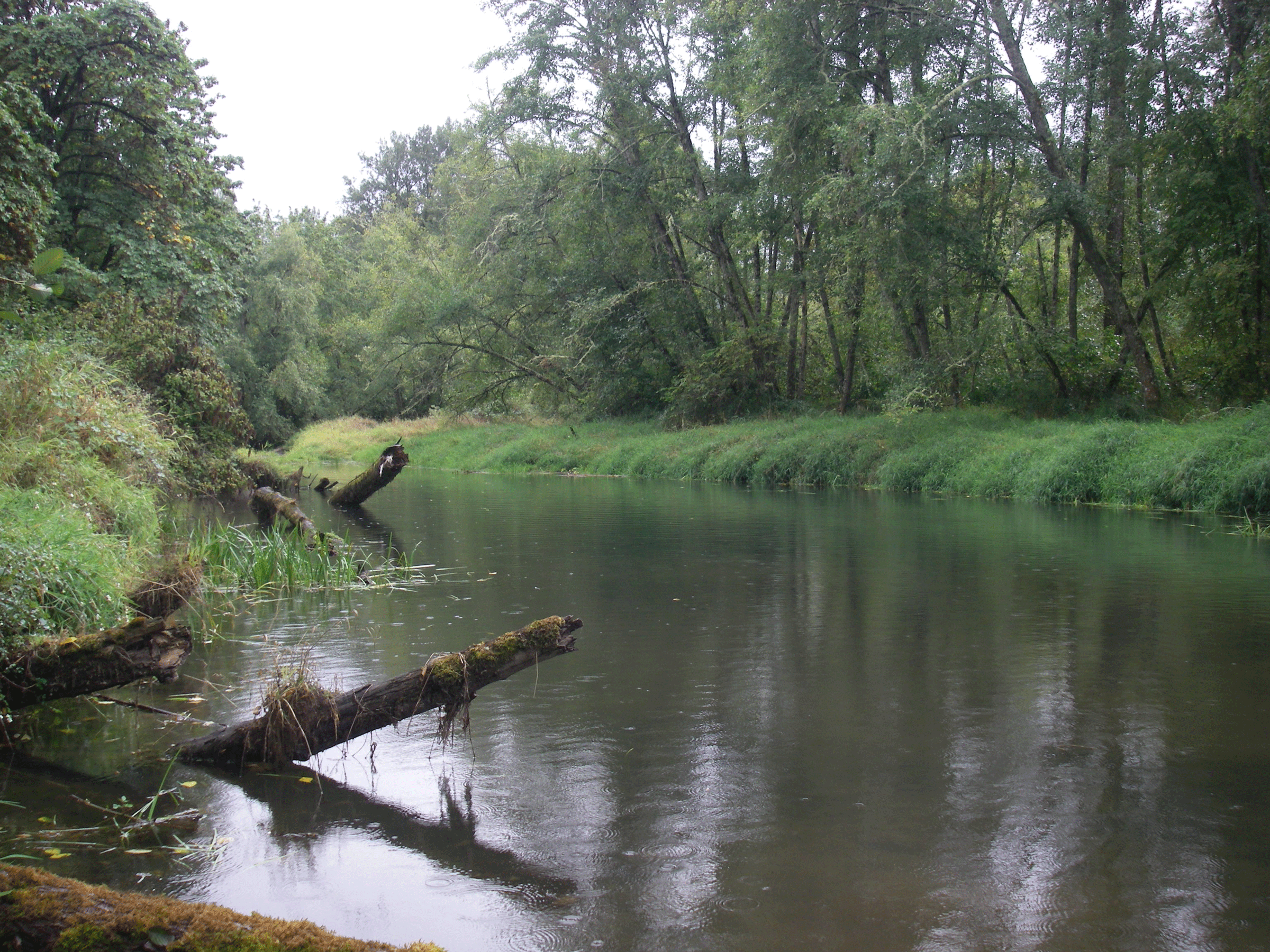
The chub pond at Ankeny National Wildlife refuge (Photo: Rick Brown)
CURWOOD: Well, many species may be heading towards extinction, but sometimes species recover, and we have news of one now. A tiny minnow called the Oregon Chub is on the road to be taken off the Endangered Species List. This little fish lives only in the Willamette Valley of Oregon and was first ruled endangered more than 20 years ago. The chub started to rebound, and by 2011 it was classified as merely threatened. Now officials are saying it’s fully recovered, and want it removed from Endangered Species List altogether—which would be a first for fishes. Cassandra Profita from the public media collaborative EarthFix has our story.
AUER: Hank! Come.
PROFITA: John Auer and his dog Hank are in the middle of his family's 900-acre farm near Monmouth. After strapping on some waders, Auer pushes through thick tangles of grass and sinks into brown, swampy water.
AUER: Home base for the chub is inside here.
PROFITA: On about 30 acres of the farm, Auer has teamed up with wildlife managers to expand the marshlands around Jont Creek. They removed soil and replaced some invasive reed canary grass with native plants. Auer says the idea was to improve habitat for salmon, steelhead and waterfowl.
AUER: I go duck hunting out here twice a year, maybe. The rest of the time it's theirs. They can have it.
PROFITA: But in the process of sampling the fish in the new habitat, a biologist with Oregon Department of Fish and Wildlife found many other lesser-known species.
AUER: He just pulled these little crawdad trap-like things up, and he caught like 250 fish – little fish of all different kinds that I didn't even know were in here.
PROFITA: In a pond behind a beaver dam, the traps revealed dozens of a native minnow called Oregon chub. This little fish – which grows no more than three inches long – has been on the endangered species list since 1993.
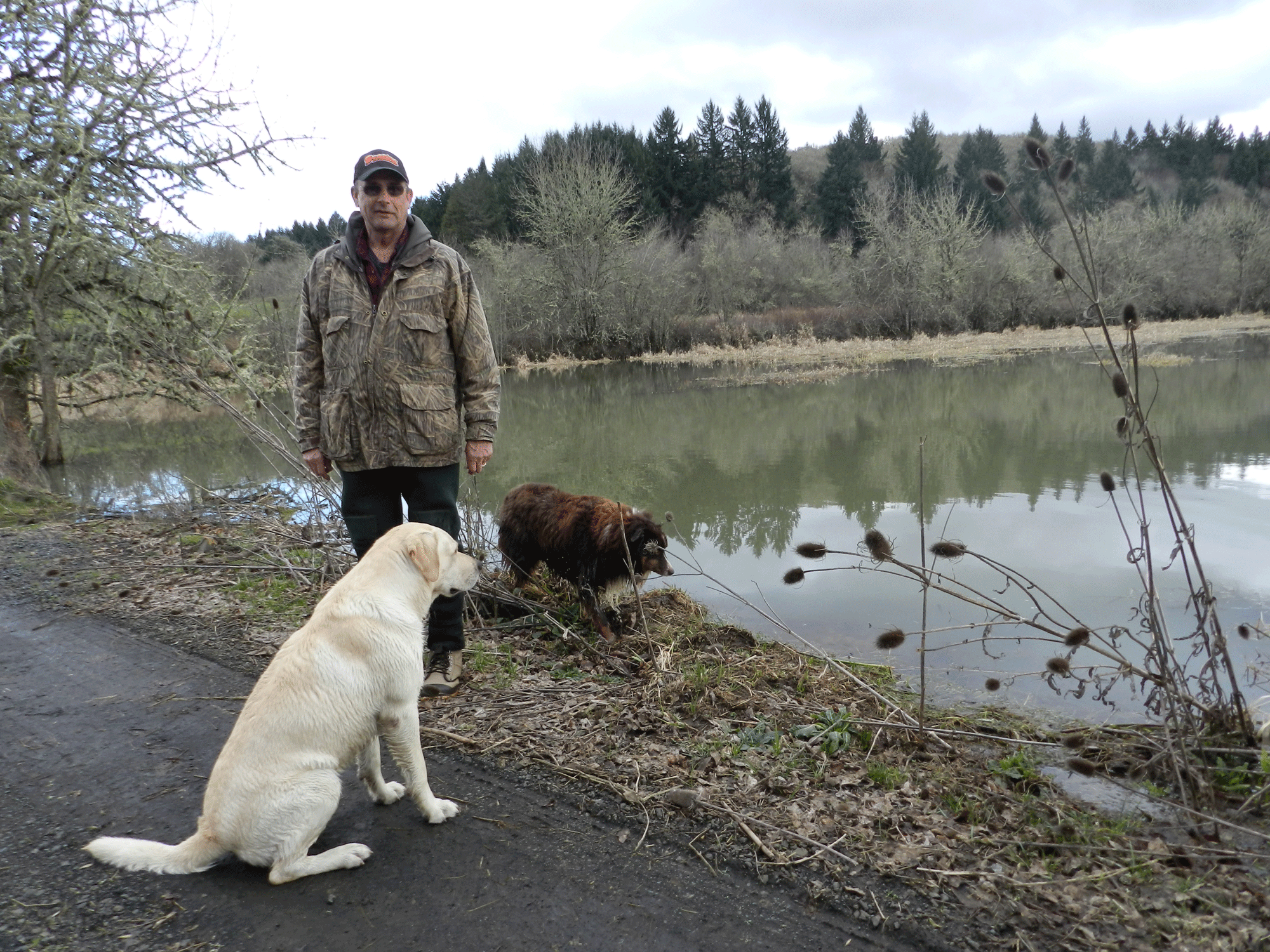
Jon Auer with his dogs next to his chub pond (photo: Casandra Profita)
AUER: Well, he told me they were a threatened species. I was taken aback. I had no idea they would be here or that there even was that kind of fish.
PROFITA: Brian Bangs is the biologist who found the chub on Auer's property. He's been working to recover the species since 2005 – wading into Willamette Valley muck to look for them and at times getting stuck in the process. He says the fish can be a bit underwhelming in appearance.
BANGS: Yeah, they don't look like much, but really they're representative of a lot of the habitat we used to have here in the valley – the swampy, slough habitat that was prevalent in the bottom of the valley before colonization and industrialization.
PROFITA: Most people don't know about Oregon chub. They're certainly not a fish anglers try to catch. Though they do get eaten by a lot of game fish—and that was part of the problem.
BANGS: Bass, bluegill, crappie, bullhead. These were brought rover and introduced as sport fish. And, Oregon chub hide in vegetation, and this is the same spot where a lot of predators are hunting.
PROFITA: Biologists came up with a simple plan to keep the invasive fish from eating the minnows to the point of extinction: They introduced chub to predator-free ponds, where their numbers could grow.
That helped with another problem chub faced, which was the loss of ponds and sloughs. Bangs says the construction of dikes and dams to control flooding eliminated a lot of the marshlands chub like to call home.
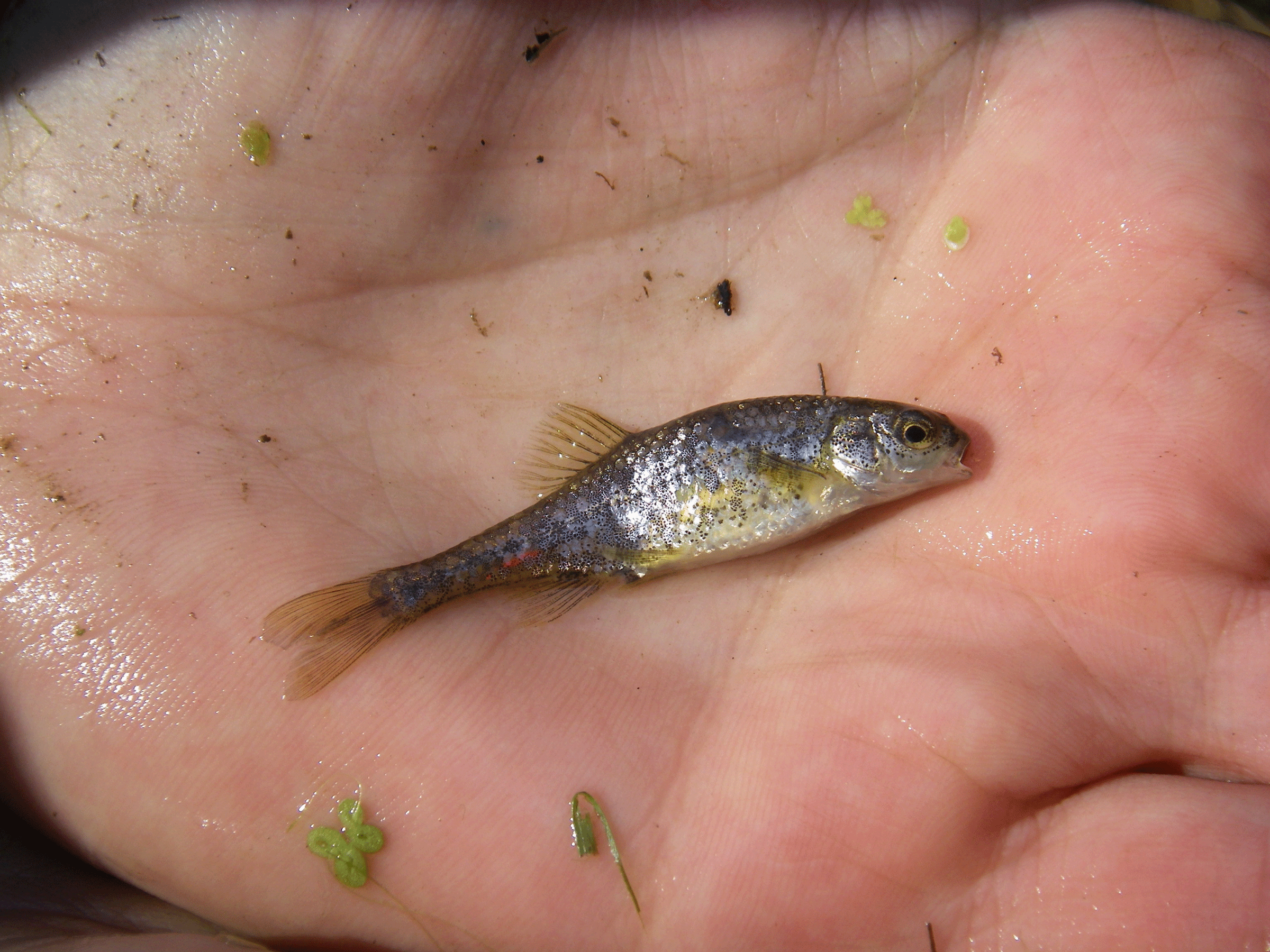
Brian Bangs holds an Oregon Chub in his hands (photo: Oregon Department of Fish and Wildlife)
BANGS: Chub like silty, muddy substrates – the kind of places where you say ‘I'm not drinking that water.’
PROFITA: Project leader Paul Scheerer has been working to recover chub since they were first listed. He says in a way, the fact that chub keep a low profile has helped them recover. It was painless for many landowners to add chub ponds without changing their farm or forest operations.
SCHEERER: The fact that they are small and don't have a big effect on a lot of people made our job a little bit easier.
PROFITA: Meanwhile, efforts to improve salmon and steelhead habitat by allowing more water flows through dams on the Willamette River have also been helped the lesser-known chub. When the fish were listed as endangered, biologists could account for less than 1,000 Oregon Chub. Now, there are around 160,000 of them. A large chunk of their new habitat is on private land like Auer's family farm.
SCHEERER: We have a little fish that most people didn't know about, few people care about and we've managed to recover them in a working landscape. I think it demonstration that it can be done.
PROFITA: Paul Henson is the state supervisor for the US Fish and Wildlife Service in Oregon. He says everyone agrees these little fish no longer needs endangered species protection.
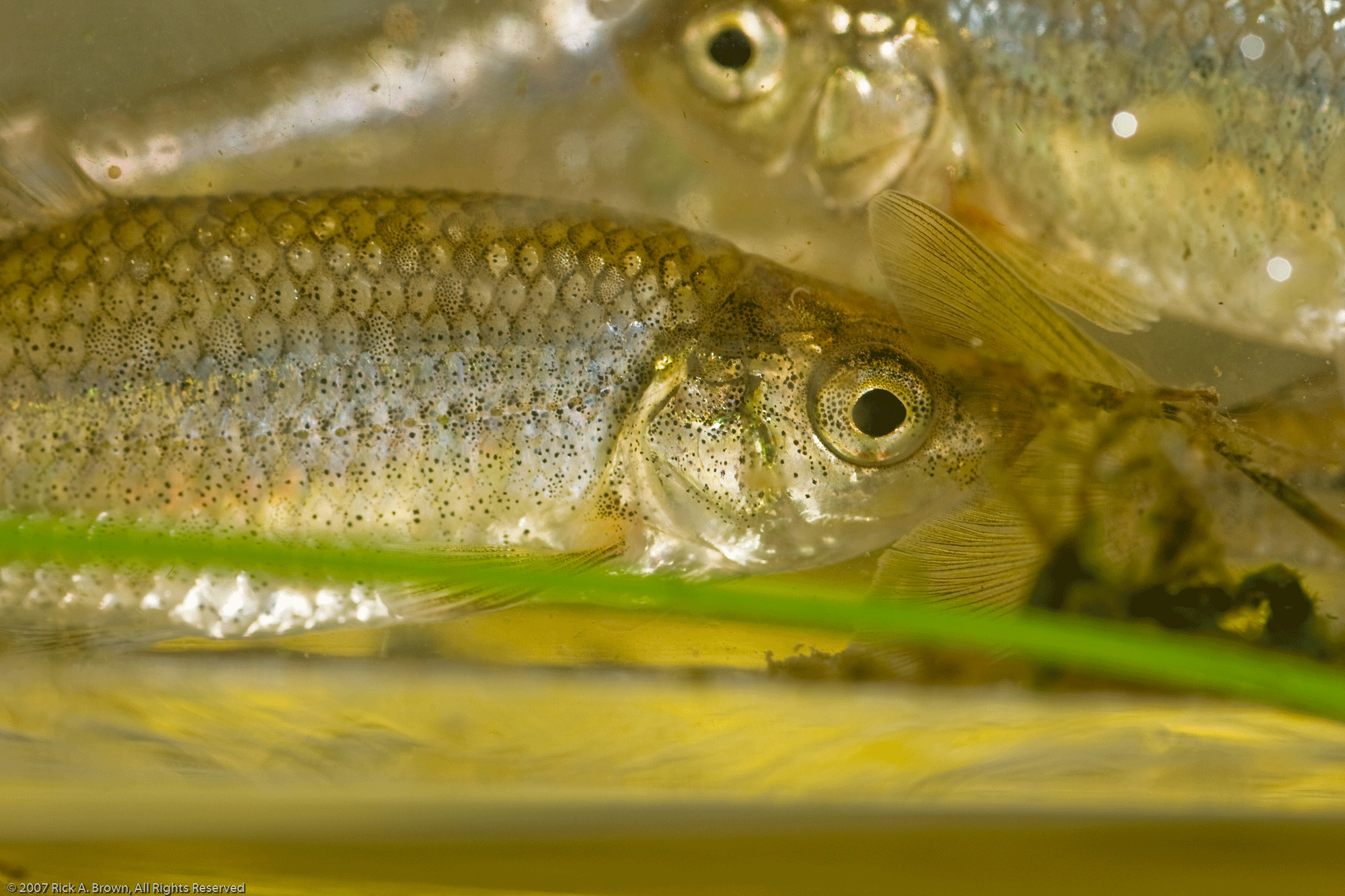
A pair of Oregon chub from the Ankeny National Wildlife refuge (Photo: Rick Brown)
HENSON: Oregon Chub—it’s so clearly recovered now. I have not heard of anyone disagreeing with the decision here. I'd say it's pretty much a consensus that the time is right.
PROFITA: That's a big deal because while other fish have been removed from the endangered species list. It hasn't been because their populations rebounded. Take the long jaw cisco, blue pike and tecopa pupfish. They all came off the list – because they went extinct.
HENSON: Overall in the United States we have 1400 species listed: Fish, plants, birds, insects. And there’s not yet been a fish yet proposed for delisting due to recovery.
PROFITA: A thriving population of Oregon Chub isn't just good news for the future of these minnows. It's also one more step in making the Willamette Valley a healthier place for the native birds, reptiles and other fish that live in the same swamps; and rely on the Oregon chub as part of their food chain.
PROFITA: That’s why John Auer says he’d be happy to add another chub pond to his family farm – whether the fish are endangered or not.
I’m Cassandra Profita reporting.
CURWOOD: Cassandra reports for the public media collaborative EarthFix.
Related link:
Check out this story and more from our friends at EarthFix
[MUSIC: Bombay Dub Orchestra “Map Of Dusk” from 3 Cities (Six Degrees Records 2008)]
CURWOOD: Next time on Living on Earth, Flea collars bring pets relief from biting and stinging insects – but there’s a problem –
ROTKIN-ELTMAN: Flea collars are designed to work by spreading that pesticide on the pet, and when kids come in contact with their pet which they do on a daily basis, they come into contact with that very toxic pesticide.
CURWOOD: And an EPA ban on some collars won’t take effect for some time -- that's next time on Living on Earth.
CURWOOD: Living on Earth is produced by the World Media Foundation. Naomi Arenberg, Bobby Bascomb, Emmett Fitzgerald, Helen Palmer, Adelaide Chen, James Curwood, Lauren Hinkel, Jake Lucas, Abi Nighthill, Jennifer Marquis, and Olivia Powers all help to make our show. We had help this week from Rosa Curson-Smith. Jeff Turton is our technical director. Alison Lirish Dean composed our themes. You can find us anytime at loe.org – and like us, please, on our Facebook page. It’s PRI’s Living on Earth, and we tweet from @livingonearth. I’m Steve Curwood, thanks for listening!
ANNOUNCER 1: Funding for Living on Earth comes from the Grantham Foundation for the protection of the environment, supporting strategic communication and collaboration in solving the world’s most pressing environmental problems. The Kendeda Fund, furthering the values that contribute to a healthy planet, and Gilman Ordway for coverage of conservation and environmental change. Living on Earth is also supported by Stonyfield Farm—makers of organic smoothies, yogurt, and more: www.stonyfield.com.
ANNOUNCER 2: PRI, Public Radio International.
Living on Earth wants to hear from you!
Living on Earth
62 Calef Highway, Suite 212
Lee, NH 03861
Telephone: 617-287-4121
E-mail: comments@loe.org
Newsletter [Click here]
Donate to Living on Earth!
Living on Earth is an independent media program and relies entirely on contributions from listeners and institutions supporting public service. Please donate now to preserve an independent environmental voice.
NewsletterLiving on Earth offers a weekly delivery of the show's rundown to your mailbox. Sign up for our newsletter today!
 Sailors For The Sea: Be the change you want to sea.
Sailors For The Sea: Be the change you want to sea.
 The Grantham Foundation for the Protection of the Environment: Committed to protecting and improving the health of the global environment.
The Grantham Foundation for the Protection of the Environment: Committed to protecting and improving the health of the global environment.
 Contribute to Living on Earth and receive, as our gift to you, an archival print of one of Mark Seth Lender's extraordinary wildlife photographs. Follow the link to see Mark's current collection of photographs.
Contribute to Living on Earth and receive, as our gift to you, an archival print of one of Mark Seth Lender's extraordinary wildlife photographs. Follow the link to see Mark's current collection of photographs.
 Buy a signed copy of Mark Seth Lender's book Smeagull the Seagull & support Living on Earth
Buy a signed copy of Mark Seth Lender's book Smeagull the Seagull & support Living on Earth

